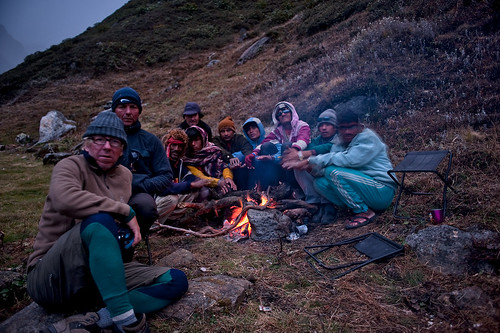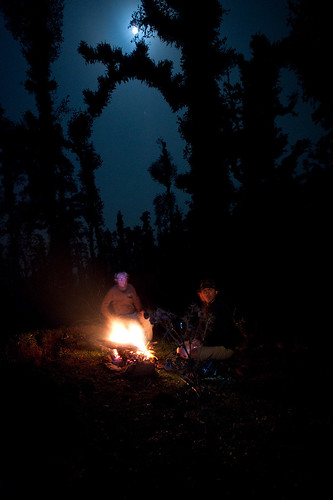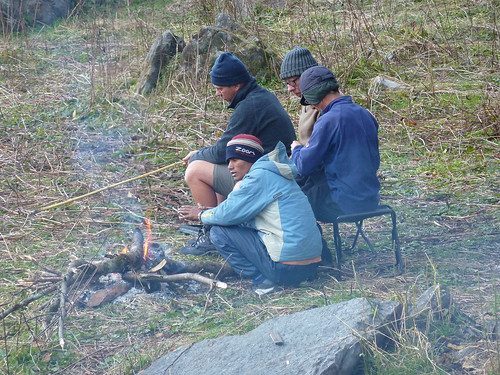
Just a note
Before I continue recounting our adventures in India I shall just wait until I've posted all the photographs that go with the Himalayan part of the trip. Meanwhile I shall post some asides on various aspects of the trekking life.
On the Joys of Campfires
It’s difficult to resist the pleasure of a campfire when on the trail but, of course, I often do. It doesn’t seem quite the same when you’re hiking alone and neither does it when you are camped in a designated site. I’ve enjoyed fires in in State Parks in the USA and recently in a campsite in Wales with Keith and Linford, but making a fire on a supplied hearth with wood bought from the camp shop doesn’t really count. One of the great pleasures of camping out in the wild with a group of friends is the evening spent around the fire.
Of course it’s not always possible to have a fire. We weren’t camped every night on this last trip and had six nights in Rest Houses in small villages along the way. We also had three nights camped above the tree-line so it was impossible to collect fuel. It was also far too cold to even contemplate a fire anyway. We also had one night where it rained so we didn’t bother there either! In total we had 18 days trekking so taking into account those days above we had 8 possible nights of campfires. We didn’t make a fire on the first night and we didn’t when we camped by the river in Bhairan Gati; we didn’t really have a lot of room there. In addition the fires we did light for both nights in Pawali Kanta were spoiled by the onset of drizzle. That leaves only 4 nights of successful campfires. That seems disappointingly low in retrospect!
So the fires we had were at Nilara, Belak Khal, Chauki and Kalyani, but let’s include both nights at Pawali Kanta because we did at least go to the effort of making fires there even though we didn’t get much time to enjoy them.
Making a campfire is often just a series of satisfying rituals. After recovering from the hours spent on the trail and pitching your tent and sorting out your gear you find you have time on your hands. It’s often only early afternoon; a six or seven hour hike will still see you arriving at your destination at about 3 or 4pm. After a welcome cup of tea some people settle down to read or get their diary up to date, but this is the ideal time to do some foraging. It always amuses me that once someone gets going on this then invariably the whole group does. Sometimes it can get a bit competitive as we attempt to get the biggest logs.
Next comes the ritual of building a fireplace. Usually this is no more than a circle of rocks collected from close by, but when in the mood we can add extravagant details. This might just be collecting and re-arranging other rocks to sit on. I remember one time on the last trip to the Himalayas in 2005 that we went to huge trouble to build bench seating all around the hearth. In Venezuela we once plaited the leaves of the Frailejon plant to make some seat covers!
One thing I like to do at this point is to divide all the fuel into different sized piles. This involves breaking off all the twigs and side branches from what has been collected and leads into the next ritual which is building the fire itself.
We often have a whip round to discover all the bits of paper we might have. Wrappers and the like. Once or twice we’ve been so disgusted at the state of some camp sites that we’ve spent some time collecting the litter left by previous groups. It’s one of the most dispiriting things about trekking that you still have to encourage people to dispose of waste properly. Some of the porters have the irritating habit of dropping sweet wrappers as they go! Anyway the paper is first and then some kind of kindling. This might be pine cones, bark, straw or just tiny twigs. James has the habit of collecting suitable stuff whilst on the trail so he might have a pocket full of stuff to get us going. James is often the one who likes to build the tepee of kindling and twigs at the heart of the fire before going on to overlay it with larger twigs and logs. A well laid fire can be a work of art!
Once that is all done and ready it may be several hours before we actually get around to lighting it. We usually like to wait until dark. Sometime it’s lit before dinner in which case it’s a bit of a lottery if it’s still alight afterwards, but usually the fire is an after dinner ritual.
But who gets to light it? Usually the person who laid it though sometimes they are usurped by someone in a hurry to get warm! Generally we muck about with trying to light it with as few matches as possible. This generally involves a lot of blowing and sucking in of smoke and of course using a cupful of kerosene off the porters is strictly forbidden. That is unless we are struggling or the wood is damp or a porter notices our struggles and comes surreptitiously and throws a small cupful on.
Well once it’s going comes the time to enjoy it and feel the heat on your face and chest and the cold on your back. Now’s the time to fidget around the fire and avoid the smoke in your eyes. Now is the time to become mesmerised by the embers and flames and find yourself a poker. Everyone like to fiddle with a fire and poke it around and move the logs around so they burn better. Sometimes someone takes control and responsibility for getting a hot base, without too many flames and hopefully without too much smoke. More usually a strange hierarchy of stokers emerges who vie with one another to keep the fire burning.

These fires can be surprisingly silent. You would think that the conversation would be low and intense but often nothing gets said above the mundane and long periods of silence are interspersed with the crackling of the flames. I suppose that their is not a lot to say to each other when you’ve been on the trail for a couple of weeks and it’s not as if we have much news. We all did the same thing today and we all pretty much know what we’ll be doing tomorrow. I like the silence and the calm. I like looking into the fiery embers and looking up into the starlit sky above us. What else is there to do? You could go to bed. You could read. But I often stay by the fire until as late as possible. Sometime 9.30 or 10!
The final ritual is allowing the fire to gradually burn down. This is sometimes due to a lack of fuel but more often than not the last one up has to decide when and how to put it out. One of the fun things here to to try and leave the fire in such a way that it might be possible to resuscitate it in the morning without re-lighting. This can sometime be done by putting large stones over the pile of ash and embers.
I don’t remember doing this on the last trip but in 2005, James or I would often be up early to take photographs and would spend some time trying to get last nights fire going again. It’s a very pleasant feeling to get up on a cold morning and have a fire going in the campsite to keep you warm until the sun comes over the mountains.
We weren’t the only ones to have a campfire. Usually the porters would get a fire going too and even sometimes cook over it. The porters were responsible for preparing their own food whilst our cook and the guide, with two or three helpers, would prepare our food and theirs. They both had kerosene burners, but the porters would sometimes preserve the kerosene and cook over the fire. You have to remember too that one of the porters had to carry the fuel which was replenished from time to time when we passed through the larger villages.

Usually the porters would build a very small and economic fire but just occasionally they would go wild and build a bonfire. On our previous trip to the Himalayas we were camped out on the 5th of November. Inevitably we built a Guy to burn using some old hessian sacks that we’d found and stuffed them with straw and with twigs sticking out for limbs. We tried to explain the tradition and significance of this but they just found it highly amusing.

No comments:
Post a Comment